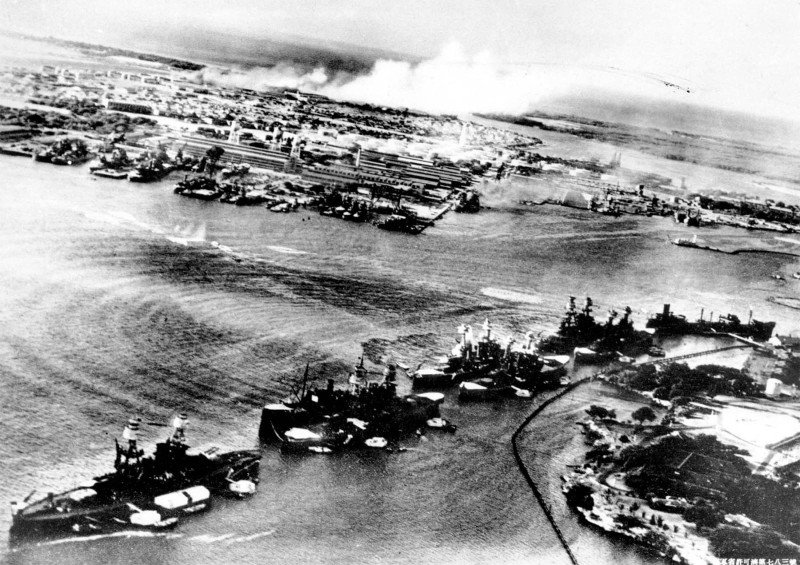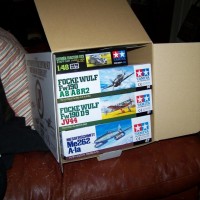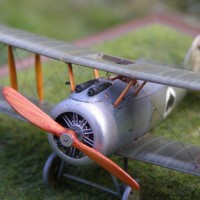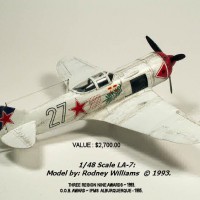80 Years Ago: "I Knew My Plans Had Changed"
The flight deck of USS Enterprise (CV-6) echoed with the command over the loudspeaker from the bridge: “Pilots! Man your planes!” Thirty-one year old Lieutenant Richard H. “Dick” Best Jr., operations officer of Bombing-Six, watched from near the ship's island as the crews of the twelve Douglas SBD-3 Dauntlesses of Scouting-Six and five SBD-2s of Bombing-Six climbed aboard their airplanes and wished he was one of the Bombing-Six crews who would be the first of the squadron to arrive home at NAS Ford Island, since he was eager to go on leave with his wife and four-year old daughter who were waiting for him in Honolulu. He glanced up and saw Vice Admiral William F. Halsey Jr. - universally known in the Navy as “Bull,” though no one ever used that to his face - watching the preparations for takeoff from the admiral's bridge as commander of Carrier Division Two. Best could see the four heavy cruisers of Cruiser Division 5 commanded by Rear Admiral Raymond A. Spruance aboard his flagship USS Northampton (CA-26) and six destroyers that constituted Task Force 16 as grey shapes on the horizon.
Commander Howard L. “Brigham” Young climbed aboard the blue-grey over light grey Dauntless marked “Commander Enterprise Group” on its flank designating it as the Group Commander's airplane that would lead the five Bombing-Six SBD-2s. The Admiral's assistant operations officer, LCDR Bromfield Nichol, eased himself into the gunner's rear seat in Young's airplane; seven years before, then-Lieutenant Nichol had been then-Captain Halsey's flight instructor at Pensacola when Halsey had been awarded his Wings of Gold on May 15, 1935 at age 52, the oldest man to ever qualify as a naval aviator. Nichols' briefcase carried Halsey's report to Pacific Fleet Commander Admiral Husband E. Kimmel regarding the Wake Island operation.
Eighteen R-1830 radial engines coughed to life and soon their throbbing rumble filled the air. For the first time since November 28 when Task Force 16 had departed Pearl Harbor, the sky was clear and the rising sun could be clearly seen. The heavy seas encountered during the return from Wake Island, where the task force had delivered eighteen F4F-3 Wildcats of the Marines' VMF-212 to provide air defense for the U.S.-held island 1,993 miles from Japan, had prevented the destroyers from refueling and forced the carrier to reduce speed so that the “small boys” could keep station. Enterprise had been scheduled to drop anchor in Pearl Harbor the previous afternoon, December 6. Instead, here she was on Sunday, December 7, 1941, launching a full-scale 90-degree search perimeter from 225 miles south of the Hawaiian Islands to ensure the safety of the ships as they returned to the major American naval base in the Pacific.
When Enterprise departed Pearl Harbor at the end of November, Admiral Halsey issued Battle Order No. 1, placing the fleet on a wartime footing in expectation of a possible encounter with Japanese forces. Training ammunition was stored below and replaced with “service ammo,” while the pilots of Air Group Six were cleared to attack any ship or aircraft spotted because there were no “friendlies” ahead of Task Force 16. The admiral had concluded, “If anything gets in my way, we'll shoot first and argue afterwards. When put to the test, all hands keep cool, keep your heads, and FIGHT.” Lieutenant Best was in complete agreement with his commander.
Still, even in the face of the news over the previous five months, despite the fact the Gallup Poll showed a majority of their fellow citizens expected a war, most of the men aboard Task Force 16 could not bring themselves to believe that a war with Japan could truly be imminent. Yeoman Second Class Bill Norberg, who worked in the captain's office aboard Enterprise, later remembered, “We in the captain's office never mentioned impending war. We looked on the Japanese as squint-eyed midgets due to lack of knowledge. Battle order Number One was to us somewhat comparable to The Second Coming- it'll happen someday, but certainly not this week or month.”
At 0615 hours that Sunday morning, Enterprise turned into the wind and commenced launching the eighteen Dauntlesses. No American knew that at the same time, some 500 miles north of Enterprise's position, six Japanese aircraft carriers that had departed Hokkaido two days before Enterprise departed Pearl Harbor, were launching 183 fighters, dive bombers and torpedo bombers: nine Nakajima B5N2 bombers armed with 800 kg (1760 lb) armor-piercing bombs; 40 B5N2 bombers carrying Type 91 aerial torpedoes; 51 Aichi D3A1 dive bombers with 249 kg (550 lb) general-purpose bombs; and 43 Mitsubishi A6M2 Type 0 fighters.
The eighteen search planes set off in nine formations of two, each assigned a segment of the search area. By 0730 hours, when they had reached the end of their patrols, the pilots turned for Pearl Harbor. Since they were operating under radio silence, several of the backseaters took the opportunity to practice radio homing, tuning their sets to Honolulu radio stations KGMB and KGU.
After the takeoff, Dick Best returned to his office near the Bombing-Six ready-room, to complete his paperwork. The compartment had a speaker that relayed the radio messages from the airborne aircraft. Shortly after 0800 hours, his paperwork was forgotten when he heard Bombing Six's Ensign Manuel Gonzalez's high-pitched shout over the radio, “Don't shoot! This is an American plane! Do not shoot!”
Gonzalez and his wingman, Ensign Fred Weber had been assigned the northernmost search area. Just as they finished their search, they were suddenly surrounded by six strange aircraft with fixed landing gear - what would later become known as “Val” dive bombers. Before Gonzalez's rear seater, Aviation Radioman Third Class Leonard Kozalek, could deploy his machine gun, the Dauntless caught fire when it was hit by bullets fired by the strange airplanes. As the Dauntless headed toward the ocean below, carrying the first two Enterprise fliers to die in the Pacific War, Ensign Weber dived away and escaped his pursuers by flying 25 feet over the waves.
For the 36 Enterprise fliers, their entry into World War II was “come as you are.” Air group commander Young and his wingman, Ensign Perry Teaff, were passing over Barber's Point when they spotted aircraft in the sky above the Marine air station at Ewa. Young commented that it was early for the Army to be flying on a Sunday. An instant later, he saw anti-aircraft explosions in the sky over the base. At the same time, Teaff spotted a low-wing single-engine aircraft closing on the formation. A moment later, he saw bullet strikes in the tail of Young's airplane. As the attacker adjusted his aim, Teaff saw the red circles of the Japanese rising sun on its wings.
The enemy pilot overshot the two Dauntlesses and turned to make a second attack. Teaff's radioman unlimbered his single .30 machine gun, but the unknown fighter took aim at Young. “Follow me!” the group commander ordered, and Teaff followed his leader as the two dive bombers dove for the hills below. They managed to land successfully at Ford Island through a barrage of fire from the defenders.
Lieutenant Clarence E. Dickinson had been looking forward to landing at Ford Island, where his gunner, Aviation Radioman 3rd Class William C. Miller, would finish his enlistment in the Navy. Dickinson and his wingman, Ensign R. McCarthy, were approaching Barber's Point from the south at an altitude of 1,500 feet when he spotted flak bursts over the base. Beyond, he saw the explosions aboard the battleships moored to Ford Island at Battleship Row. Climbing for a better look, the two Navy fliers came across two enemy fighter pilots who immediately attacked. Dickinson dived away, followed by McCarthy, and ran into four more enemy fighters. They quickly shot down McCarthy and set his Dauntless afire. McCarthy was able to bale out, landing in a tree and breaking a leg in so doing, while his gunner, Aviation Radioman 3rd Class Mitchell Cohn, died in the crash.
Dickinson, pursued by three of the enemy, kept turning to see his wounded gunner Bill Miller fire at the fighters as they flashed past. In a few minutes, Miller ran out of ammo and was wounded a second time. As one of the enemy planes crossed his nose, Dickinson cut loose with his two .50 caliber machine guns. The enemy fighter caught fire at the same moment his controls went slack under the fire of another on his tail. His left wing caught fire and the Dauntless spun in.
Dickinson was at 1,000 feet when he managed to overcome the G-forces and get out of the cockpit. He saw Miller slumped over his gun as he threw himself off the wing. A moment later he pulled the ripcord, and landed in a cane field in time to see his airplane hit the ground and explode. Twenty-two year old Bill Miller died on the day that was supposed to be his last in the Navy.
Back aboard Enterprise, Admiral Halsey had just poured himself a second cup of coffee when his aide dashed into the cabin. “Admiral, there's an air raid on Pearl!” Halsey's first thought was that the Army, which had been scheduled to conduct a readiness exercise the week before, was taking things too far. He leapt to his feet, telling his aide to radio Kimmel that the Army was “shooting down my own boys!” A second aide entered with a message direct from Admiral Kimmel: “AIR RAID PEARL HARBOR X THIS IS NO DRILL.”
Officer of the Deck Lieutenant John Dorsett ordered General Quarters. 19-year old Seaman Jim Barnill, one of Enterprise's four buglers, sounded the staccato notes of “Boots and Saddles.” Twenty-eight year old First Class Bosun's Mate Max Lee played his pipe over the 1MC then called “General Quarters! General Quarters! All hands man your battle stations!” Lee's enlistment was almost up. After the war, he remembered that he then turned to OOD Dorsett and said “We're at war and I'll never get out of the Navy alive.”
Dick Best remembered coming onto the flight deck shortly after general quarters had been called and looking up at the island. “The first thing I saw was the biggest American flag I had ever seen, flying from the masthead and whipping in the wind. It was the most emotional sight of the war for me.”
Adapted from: “I Will Run Wild: The Pacific War From Pearl Harbor To Midway”





No better tribute to this fateful day, Tom.
Thanks for sharing this here.
I like your story. It will be nice to build such Dountless. A long time ago there was set of decals for SBd-2.
My Dad was aboard the USS Pensylvannia in late 1941, stationed and in dry dock at Pear Harbor on this day. A kid from the Midwest on a battleship in Hawaii! Then he got notice of transfer to a cruiser doing convoy escort in the North Atlantic. My dad always used to say "I always wondered who I'd p****d off". Fate. Later he saw combat in the South Pacific. The greatest generation.
Gripping story. Thanks you for sharing .
A moment in History that needs to be told for ever.
My now long deceased across the street neighbour, Howard Poe claimed that he shot down the first plane in the war as Japanese planes strafed The Airfield He was at. ( With a Rifle ) He was a Marine, I’m not sure which Airfield he was at.
He fell sick with an illness after and was in a Medical ward on Midway Island when the Empire attacked it in 1942.
Anyways he went around all celebrations over this day with this claim. Even having business cards printed with this fact, or story.
Legends and fact blur the lines.
In the late 1960's my father was stationed at Hickam AFB on Oahu. The building he worked in was strafed during the Pearl Harbor attack. You could still see missing chunks from the bullet strikes on the building's concrete walls. A friend of mine and I used to play on the old airstrip on Ford Island (in the middle of Pearl Harbor) among the large piles of debris left over from the attack. Since then, the island has been cleaned up and it's now used for military housing.
Once again, Tom, a great telling of that fateful day...
Nice tribute Tom
@tcinla, thanks for that. ?
Great writing, Tom @tcinla.
Thanks a lot.
Thanks for this Tom, splendid writing as usual. Best from Europe.
Love this.